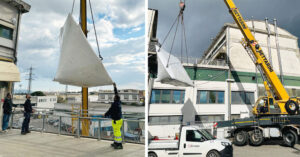
Our 40-year history:
table tennis
Why is Comtest Engineering founder Hein de Groot holding a table tennis bat in this 1988 photo? This year, we are celebrating our 40th anniversary, and every five weeks, we share a bit of Comtest’s history.



Advancements in wireless communication technologies will increase the demand for passive intermodulation (PIM) testing. In a series of five posts, our specialists share trends and developments for 2025. This week, R&D Engineer Dmitriy Penkin (in the photo on the left) will discuss PIM testing in 2025.
Dmitriy: “PIM can reduce receiver sensitivity and, in some cases, may even completely inhibit communication. Recognising and mitigating the PIM problem is essential for increasing system reliability and reducing operation costs. In our R&D department, we study the sources and causes of PIM and design solutions to detect and solve it.”
How can telecommunication companies prevent PIM from happening in the future? Dmitriy: “Base stations and mobile equipment OEMs must secure reliable communications. Accurate PIM measurements and related troubleshooting campaigns are only possible in an anechoic chamber that is properly designed and characterised by very low PIM levels, such as the chamber in the photo we built for a large telecom network provider. At our Comtest Engineering R&D department, we apply extensive and expanding knowledge to equip our clients with a chamber solution designed as ‘PIM-free’: such a test chamber has an aluminium shielding enclosure since we aim to replace all ferromagnetic materials with non-magnetic alternatives. Think also of specific aluminium or plastic screws, wooden test benches, special rails and more. Last but not least, we continuously work on optimising microwave absorbing material to ensure minimal nonlinearities within the anechoic chamber.”
For more information on our test chamber solutions for PIM testing, contact Marc Le Roy, Uliana Trucchi, Vincent van de Vrie, or Hanneke Mertens – van Veen.